Dhar
Dhar is a city located in the Malwa region of western Madhya Pradesh state in India. It is the administrative headquarters of Dhar District, and was the capital of the Dhar princely state as Dharanagar from 1732 (previously the Raja had his seat at Multhan from 1728).
Dhar | |
|---|---|
City District HQ/Municipal Council | |
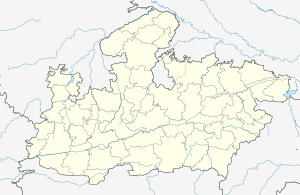 Dhar  Dhar | |
| Coordinates: 22.598°N 75.304°E | |
| Country | India |
| State | Madhya Pradesh |
| District | Dhar |
| Government | |
| • Type | Municipal Council |
| • Body | Dhar Municipal Council |
| Elevation | 559 m (1,834 ft) |
| Population (2011) | |
| • Total | 93,917 |
| Demonym(s) | Dharwasi |
| Languages | |
| • Official | Hindi |
| Time zone | UTC+5:30 (IST) |
| Vehicle registration | MP-11 |
| Website | www |
Location
Lying between 21°57' and 23°15' north, and 74°37' and 75°37' east. Bordered on the north by Ratlam; east by parts of Indore; on the south by Barwani, and on the west by Jhabua and alirajpur The town is located 34 miles (55 km) west of Mhow, 559 m (1,834 ft) above sea level. It is picturesquely situated among lakes and trees surrounded by barren hills, and possesses, besides its old ramparts, many interesting buildings, some of them containing records of cultural, historical and national importance.[1]
Historic Places and Monuments

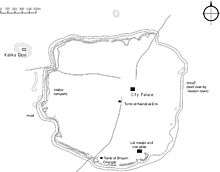
The most ancient parts of Dhār visible are the massive earthen ramparts which are best preserved on the western and southern sides of the town. These were probably built beginning in the ninth century and show that the city was circular in plan and surrounded by a series of tanks and moats. The layout is similar to the circular city of Warangal in the Deccan. The circular ramparts of Dhār, unique in north India and an important legacy of the Paramāras, is being destroyed by brick-makers and others using the material for construction purposes. On the north-east side of the town, the rampart and moat have disappeared beneath modern homes and other buildings.
Fort

The historic parts of the town are dominated by an impressive sandstone fortress on a small hill. It is thought to have been built by Muhammad bin Tughluq, the Sultan of Delhi, probably on the site of the ancient Dhārāgiri mentioned in early sources.[2] One of the gateways, added at a later time, dates to 1684-85 in the time of 'Ālamgīr.[3] Inside the fort is a deep rock-cut cistern, of great age, and a later palace of the Mahārāja of Dhār incorporating an elegant pillared porch of the Mughal period that probably belongs to the mid-seventeenth century. In the palace area is an outdoor museum with a small collection of temple fragments and images dating to medieval times.
Tomb of Shaykh Changāl
On the overgrown ramparts of the medieval city, overlooking the old moat, is the tomb of Shaykh ‘Abdullah Shāh Changāl, a warrior saint. The tomb has been rebuilt, but the inscription, now incorporated into the compound gate, is written in Persian and dated 1455. A record of historical interest, it recounts the Shaykh's arrival in Dhār and his conversion of Bhoja to Islām after the local people had committed an atrocity against the small community of Muslims who had settled in the city in the earliest days of Islam.[4] The story does not so much refer to the celebrated Bhoja but to a rising interest in Bhoja's biography in the fifteenth century and the attempts made at that time to appropriate his legacy in Sanskrit and Persian literary sources.[5]
Pillar Mosque
The Lat Masjid or 'Pillar Mosque', to the south of the town like the tomb of Shaykh Changāl, was built as the Jami' Mosque by Dilawar Khan in 1405.[6] It derives its name from the iron pillar of Dhar ("lāṭ" in Hindi), which is believed to have been set up in the 11th century.[7][8] The pillar, which was nearly 13.2 m high according to the most recent assessment, is fallen and broken; the three surviving parts are displayed on a small platform outside the mosque. It carries a later inscription recording a visit of the Mughal emperor Akbar in 1598 while on campaign towards the Deccan. The pillar's original stone footing is also displayed nearby.
Kamāl Maulā Campus
The Kamāl Maulā is a spacious enclosure containing four tombs, the most notable being that of Shaykh Kamāl Maulavi or Kamāl al-Dīn (circa 1238-1330). He was a follower of Farīd al-Dīn Gaṅj-i Shakar (circa 1173-1266, see Fariduddin Ganjshakar) and the Chishti saint Nizamuddin Auliya (1238–1325). Some details about Kamāl al-Dīn are recorded in Muḥammad Ghauthi's Azkar-i Abrar, a reliable hagiography of Sufi saints composed in 1613.[9] The cloak presented to Kamāl al-Dīn by Nizam al-Dīn is still displayed inside the tomb. The custodians of Kamāl al-Dīn's tomb have served in an unbroken lineage for 700 years and are still resident.[10]
Bhoj Shala
The hypostyle hall immediately next the tomb of Kamāl Maula is made of re-cycled temple columns and other architectural parts except for the Mihrab and Minbar which were purpose-built for the monument. It is similar to the Lāṭ Masjid though earlier in date as an inscription of A.H. 795/C.E. 1392 found nearby records repairs by Dilāwar Khān.[11] A Sanskrit and Prakrit inscription from the time of Arjunavarman (circa 1210-15) was found in the walls of the building in 1903 by K. K. Lele, Superintendent of Education in the Princely State of Dhār. The engraved inscription is displayed inside the entrance. The text includes part of a drama called Vijayaśrīnāṭikā composed by Madana, the king's preceptor who also bore the title 'Bālasarasvatī'.[12] The other inscribed tablets noted by Lele included a large tablet inscribed with the Kūrmaśataka—verses in praise of the Kūrma incarnation of Viṣṇu—and a serpentine inscription giving grammatical rules of the Sanskrit language. The finds, particularly the grammatical inscription, prompted Lele to describe the building as the Bhoj Shala or 'Hall of Bhoja', because King Bhoja (circa 1000-55) was the author of a number of works on poetics and grammar, among them the Sarasvatīkaṇṭhābharaṇa or 'Necklace of Sarasvatī'.[13] The term 'Bhoj Shala' was first published by Luard in 1908.[14] The subsequent controversy surrounding the building and its identity is discussed under Bhoj Shala.
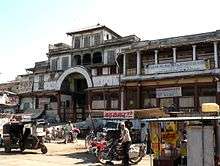
Cenotaphs and Old City Palace
The old city palace of the Puar (Pawar) clan, a branch of the Marathas, is now used as a school. It is a modest building put up in the late 19th century around 1875. A marble statue of the Jain goddess Ambikā, found in 1875 on the site of the palace is now in the British Museum.[16] Of the same period as the palace are a collection of domed cenotaphs of the Powar rulers on the edge of the large tank known as Muñj Talab. The name of the tank probably derives from Vākpati Muñja, the 10th century Paramāra king who first entered Mālwa and made Ujjain his main seat.[17]
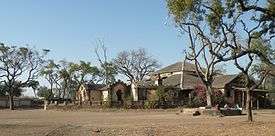
Museum
A number of sculptures and antiquities from Dhār and its neighborhood are kept in the local museum, a utilitarian stone building in the British style of the late 19th century. The most important pieces from the collection have been moved to Mandu where the Department of Archaeology, Museums and Archives has created a new museum with a wide range of displays.
Agency House
Another colonial building at Dhār, located outside the old town on the road to Indore, is Agency House. It was built by the Public Works Department and was the centre of the administration of Dhar State and the Central India Agency.[18] The building has been abandoned and is now in ruins.
Jheera Bagh

Outside the town, off the road to Māṇḍū, the Powars, built a palace at Hazīra Bāgh from the 1860s. Known as the Jheera Bāgh Palace and now run as a heritage hotel, the complex was renovated by Mahārāja Anand Rao Pawar IV in the 1940s. Graciously designed in an unpretentious art deco style, it is one of the most elegant and forward-looking examples of early modern architecture in North India.
Political history
The town of Dhār, the name of which is usually derived from Dhārā Nagara ('city of sword blades'), is of considerable antiquity,[1] the first reference to it appearing in an inscription from Jaunpur belonging to the Maukhari dynasty.[19] Despite this sixth century reference, Dhār only rose to historical prominence when it was made the seat of the Paramara chiefs of Malwa by Vairisiṃha (circa 920-45 CE). He appears to have transferred his headquarters hither from Ujjain. During the rule of the Paramāras, Dhār became famous throughout India as a centre of culture and learning,[1] especially under king Bhoja (circa 1000-1055). The wealth and splendor of Dhār drew the attention of competing dynasties during the 11th century. The Cāḷukyas of Kalyāṇa under Someśvara I (circa CE 1042-68) captured and burnt the city, occupying also Māṇḍū (ancient Māṇḍava).[20] Slightly later Dhār was sacked by the Cāḷukyas of Gujarāt under Siddharāja.[21] The devastation and political fragmentation caused by these wars meant that no significant opposition was offered when Sultān of Delhi, Ala ud din Khilji dispatched an army to Mālwa in the early 14th century. The region was annexed to Delhi and Dhār made the capital of the province under 'Ayn al-Mulk Mūltānī. He served as governor until 1313.[22] Events during the following seventy years are unclear, but some time in A.H. 793/C.E. 1390-91 Dilawar Khan was appointed muqṭi' of Dhār (and so governor of Mālwa) by Sulṭān Muḥammad Shāh.[23] Dilāwar Khān took the title 'Amīd Shāh Dā'ūd and caused the khutba to be read in his name in A.H. 804/C.E. 1401-02, thereby establishing himself as an independent sulṭān.[24] On his death in 1406, his son Hoshang Shah became king with his capital at Māṇḍū. Subsequently, in the time of Akbar, Dhār fell under the dominion of the Mughals, in whose hands it remained till 1730, when it was conquered by the Marathas.[1]
In late 1723, Bajirao at the head of a large army and accompanied by his trusted lieutenants, Malharrao Holkar, Ranoji Shinde (Scindia) and Udaji Rao Pawar, swept through Malwa. A few years earlier the Mughal Emperor had been forced to give the Marathas the right to collect chauth taxes in Malwa and Gujarat. This levy added much value to the Marathas, as both the king Shahu and his Peshwa, Bajirao, were ear-deep in debt. The revenues they collected from their own lands were not sufficient to run the administration of the state and finance their large military expenditure. The Marathas lived by the sword and trade was alien to them. Agriculture in the Deccan depended heavily on the timeliness and sufficiency of the monsoons. The most important source of money were therefore the chauth (a 25% tax on produce) and sardeshmukhi (a ten percent surcharge) exacted by the Marathas. The Maratha armies defeated the Mughal governor and attacked the capital Ujjain. Bajirao established military outposts in the country as far north as Bundelkhand.
Towards the close of the 18th and in the early part of the 19th century, the state was subject to a series of spoliations by Scindia of Gwalior and Holkar of Indore, (descendants of Ranoji Scindia and Malharao Holkar). It was only preserved from annihilation by the talents and courage of the adoptive mother of the fifth raja.
Dhar State
After the Third Anglo-Maratha War, of 1818, Dhar passed under British rule. Dhar State became a princely state of British India, in the Bhopawar Agency of the Central India Agency. It included many Rajput and Bhil feudatories, and had an area of 1,775 square miles (4,600 km2). The state was confiscated by the British in the Revolt of 1857, but in 1860 was restored to Raja Anand Rao III Pawar, then a minor, with the exception of the detached district of Bairusia, which was granted to the Begum of Bhopal. Anand Rao, who received the personal title Maharaja and the KCSI in 1877, died in 1898; he was succeeded by Udaji Rao II Pawar.[1]
Dhar Thikanas
A separate department to superintend Thakurs and Bhumias, Entitled "Department of Thakurans, Bhumian and Thikanejat" was established in 1921, at which time there were 22 such estates in Dhar State.
The nobles of Dhar holding jagir lands (feudatory estates), all of whom paid tribute to the Darbar, were divided between Thakurs and Bhumias.
The Thakurs with one exception were Rajput landholders whose estates were located in the north of the state. Locally, the Thakurs were styled Talukdars and their holdings called kothari. By caste there were 8 Rathor Rajputs, one Pawar and one Kayasth.
The Bhumias or "Allodial" Chiefs were all Bhilalas, a clan claiming mixed tribal Bhil people and Rajput (Chauhan) descent. Their grants were originally obtained from the Darbar on the understanding that they kept the peace among the Bhils and other wild hill tribes. They paid yearly tribute to the Darbar, while some received cash allowances (Bhet-Ghugri), an ancient feudal custom which has its origins in blackmail.abc
Political Representation and Royal Legacy
Bhartiya Janata Party politician Neena Vikram Verma serves as a Member of the Madhya Pradesh Legislative Assembly for Dhar Vidhan Sabha Constituency.[25]
In 2019 Chattar Singh Darbar of Bharatiya Janata Party had been elected as the Member of Parliament from Dhar constituency.[26]
Maharaja Shrimant Hemendra Singh Rao Pawar is present titular head of the Kshatriya Maratha-Rajput Pawar(Puar/Parmar) dynasty of Dhar State.[27][28][29][30][31]
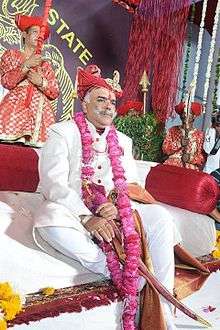
Demographics
As of 2001 India census,[32] Dhar had a population of 75,472. Males constitute 52% of the population and females 48%. Dhar has an average literacy rate of 70%, higher than the national average of 59.5%: male literacy is 76% and, female literacy is 63%. In Dhar, 14% of the population is under 6 years of age.
Postal information
In 1897 primitive stamps with entirely native text. The second definitive issue bore the name "DHAR STATE" in Latin script; a total of 8 stamps. Since 1901 Indian stamps have been in use.
Amusement and festivals
Dhar district has been on the cultural map of India since time immemorial. People used to engage themselves in fine arts such as painting, sculpture, music, and dancing. India's 2nd dinosaur remains park is set up by the Government in Dhar showing the dinosaur eggs and its remains.
Many of the Bagh cave paintings of the Gupta period have now been destroyed but whatever remain tell us about the high attainment during that period. There is a painting regarding music and dance, which is an example of the oriental Hallisak dance. The depiction of nature in its affluent forms, together with male and female figures in various emotional poses is the treasure of these caves. The construction of magnificent buildings, forts, temples, mosques, etc., during the medieval period at Dhar, Mandu and the surroundings indicate the engagements and amusements of the people of those days.
Young people draw inspiration from the famous love story of Baaz-Bahadur and Roopmati. In literature, music, dance, painting and sculpture Dhar has a very rich heritage.
During the middle of the 16th century, the science of music had attained considerable perfection in Malwa and it is said that Baaz Bahadur devoted himself to its cultivation and encouragement. His attachment to Rani Roopmati at that time become famous and the "Loves of Baaz Bahadur and Roopmati" have been handed down to posterity in song.
In rural areas, community bhajan singing at the village chaupals in the night with the accompaniment of harmonium (peti) mridang, tabala, dholak-manjire, mandal, zanch, kundi, thali, payli and dhak is the most common amusement. Vasant Pnchmi, Maha Shivaratri, Holi, Ramnavmi, Raksha-Bandhan, Nag-Panchmi, Janmashtami, Ganesh Chaturthi, Anant Chaturdashi, Sarva Pitri Amavsya, dusshera, Deepawali, Dol Gyaras, Hanuman Jayanti, etc., are celebrated with great religious zeal and enthusiasm by the Hindus Shradha Paksha (fortnight) is celebrated from poornima of Bhadra to amavasya Kunwar.
Festivals of Muslims include muharram, Id, Miladunabi, etc., which they celebrate with their traditional gaiety.
Christians celebrate Christmas and Good Friday and Jains, Mahavir Jayanti and Paryooshan etc. In some castes, Radeoji and Tejaji are worshipped once in a year on their jayantis and their respective kathas are performed. The dates of celebration are different in the various tahsils.
Pilgrim centres and Jatras
There are many religious places scattered throughout the district where people congregate at annual fairs arranged on auspicious occasions.
Dhar district has 8 tahsils inclucing Dhar itself, namely Badnawar, Sardarpur, Dhar, Dharampuri and Manawar, Gandhwani, Kukshi and Dhar.
Koteshwar, Khakrol and Badnawar are located in Badnawar tahsil; Bhopawar, Sagwal and Amjhera are located in Sardarpur tahsil; Mandu, Kesur Dhar and Sagor are located in Dhar tahsil; Lingwa and Kotda in Kukshi tahsil, Dhamnod in Dharampuri tahsil, Manawar, Bakaner and Singhana in Manawar tehsil, are a few out of a total about 40 such pilgrim centres.
Hanuman jayanti and Shivratri respectively attract thousands of pilgrims from the interiors of the District and outside, to the places of worship where special worship is offered to the concerned deities.
Gal and Biyabani Yatra, Shantinathji ka Mela, Tejaji ka Mela, Ambikaji ka Mela, Urs Kamal-ud-din and Gular Shah Urs attract thousands of followers.
Mother goddess in various forms is worshipped with special reverence. Ambika Devi (Dhar and Dhammod) Mangala Devi (Manawar) Shitalamata Devi (Bakaner) Harsiddhi Mata (Singhana) and Jagni Mata (Jhiriya pura), are a few examples.
Mandu is the place where Jehangir came and stayed with Nur Jehan. He was accompanied by Sir Thomas Roe, the English ambassador. Jehangir wrote "I know of no place so pleasant in climate and so pretty in scenery as Mandu in the rainy season. Shah Jahan too spent the rainy season of the year 1622 in Mandu. The Ram Navami fair is organised here by the mahant of the temple on Chaitra Sudi (March/April), in which thousands of people participate."
Notable natives
Baji Rao II, the last of the Peshwas, was born in Dhar.[33]
Gallery
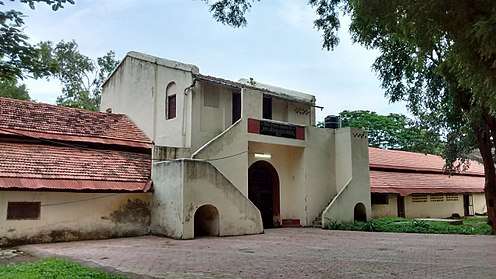
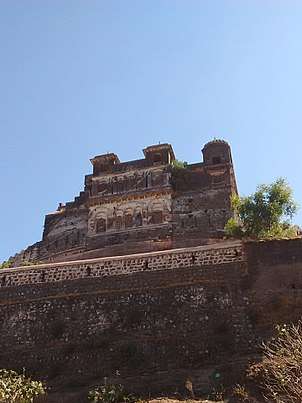


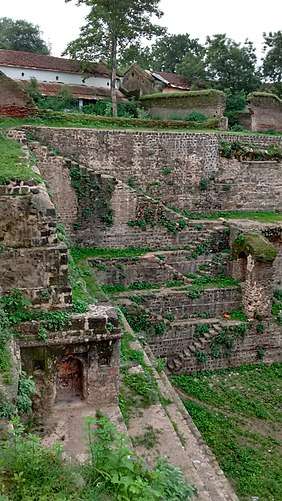



See also
External links
| Wikiquote has quotations related to: Dhar |
| Wikimedia Commons has media related to Dhar. |
References
-

- K. K. Lele, in Dikshit, Pārijātamañjarī, p. xxi, n. 1,
- Annual Report on Indian Epigraphy (1971-72): 81, no. D. 72.
- G. H. Yazdani, ‘The Inscription on the Tomb of ‘Abdullah Shāh Changāl at Dhār’ Epigraphica Indo-Moslemica (1909-10): 1-5; now translated and reinterpreted in Golzadeh, Razieh B. (2012). "On Becoming Muslim in the City of Swords: Bhoja and Shaykh Changāl at Dhār". Journal of the Royal Asiatic Society. 22 (1): 115–27. doi:10.1017/S1356186311000885.
- The point made in Golzadeh, Razieh B. (2012). "On Becoming Muslim in the City of Swords: Bhoja and Shaykh Changāl at Dhār". Journal of the Royal Asiatic Society. 22 (1): 115–27. doi:10.1017/s1356186311000885.
- Annual Report on Indian Epigraphy (1971-72): 81, no. D. 73
- Smith, V. A. "The Iron Pillar of Dhār". Journal of the Royal Asiatic Society. 1898: 143–46.
- Ray, Amitava; Dhua, S. K.; Prasad, R. R.; Jha, S.; Banerjee, S. (1997). "The ancient 11th century iron pillar at Dhar, India: a microstructural insight into material characteristics". Journal of Materials Science Letters. 16 (5): 371–375. doi:10.1023/A:1018550529070.
- Muḥammad Ghauthi Mandawi, Azkar-i abrar, Urdu Tarjuma-i Gulzar-i Abrar, trans. Fazl Ahmad Jewari [Urdu lithograph] (Agra: Matba`-i Mufid-i `Amm, 1326/1908, reprint ed., Lahore: Islamic Book Foundation, 1395/1975): 581.
- The key modern works in Rām Sevak Garg, Hazrat maulānā kamāluddīn ciśtī rah. aur unkā yug (Bhopāl, 2005).
- Luard, Dhar and Mandu (Bombay, 1916): 9; U. N. Day, Medieval Malwa (Delhi, 1969): 15, n. 2.
- S. K. Dikshit, ed., Pārijātamañjarī alias Vijayaśrī by Rāja-Guru Madana alias Bāla-Sarasvatī (Bhopal, 1968).
- R. Birwé, ‘Nārāyaṇa Daṇḍanātha's Commentary on Rules III.2, 106-121 of Bhoja's Sarasvatīkaṇṭhābharaṇa’, Journal of the American Oriental Society 1964; 84: 150-62.
- C. E. Luard, Western States (Mālwā). Gazetteer, 2 parts. The Central India State Gazetteer Series, vol. 5 (Bombay, 1908): part A, pp. 494-500; also Luard, Dhar and Mandu, p. 9
- British Museum Collection
- Kirit Mankodi, ‘A Paramāra Sculpture in the British Museum: Vāgdevī or Yakshī Ambikā?’, Sambodhi 9 (1980-81): 96-103.
- H. V. Trivedi, Inscriptions of the Paramāras, Chandellas, Kachchhapaghātas and Two Minor Dynasties, Corpus Inscriptionum Indicarum, volume 7 (New Delhi, 1978-91): 9.
- The only documentation is here: Agency House
- J. F. Fleet, Inscriptions of the Early Gupta Kings and their Successors, Corpus Inscriptionum Indicarum, vol. 3 (Calcutta, 1888): 228 (line 6). Hans T. Bakker, 'The So-Called Jaunpur Inscription of Īśvaravarman', Indo-Iran Journal 2009; 50: 207-16 shows that inscription belongs not to Īśvaravarman but to Īśānavarman or one of his successors. Online abstract: http://booksandjournals.brillonline.com/content/10.1163/001972409x12525778274224
- G. Yazdani, ed., The Early History of the Deccan, 2 vols. (London, 1960) 1: 331 according to the Nander inscription (dated CE 1047) and Nāgai inscription (dated CE 1058).
- A. K. Majumdar, Chalukyas of Gujarat (Bombay, 1956): 72-3.
- Iqtidar Husain Siddiqui, Authority and Kingship under the Sultans of Delhi (Delhi, 2006): 283-84.
- Day, Medieval Malwa, p. 13.
- Day, Medieval Malwa, p. 21.
- "Madhya Pradesh Pollmeter: Never too late". The Hindu. 5 November 2013. Retrieved 5 November 2013.
- "Dhar Election Results 2019 Live Updates: ChattarSingh Darbar of BJP Wins". News18. Retrieved 23 May 2019.
- http://www.hindustantimes.com/madhyapradesh/hemendra-singh-puar-is-head-of-erstwhile-princely-state-of-dhar/article1-1307225.aspx
- http://timesofindia.indiatimes.com/city/indore/Hemendra-Puar-to-be-new-Dhar-maharaja/articleshow/45893428.cms
- "Archived copy". Archived from the original on 25 July 2015. Retrieved 26 July 2015.CS1 maint: archived copy as title (link)
- http://timesofindia.indiatimes.com/city/indore/administration-to-remove-seal-on-dhar-royal-estates-on-hc-orders/articleshow/48211141.cms?from=mdr
- Solomon, R. V.; Bond, J. W. (2006). Indian States: A Biographical, Historical, and Administrative Survey. ISBN 9788120619654.
- "Census of India 2001: Data from the 2001 Census, including cities, villages and towns (Provisional)". Census Commission of India. Archived from the original on 16 June 2004. Retrieved 1 November 2008.
- Columbia-Lippincott Gazetteer p. 510